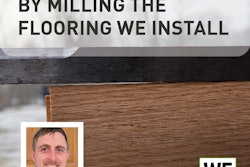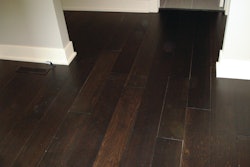The Problem
NOFMA was called to inspect a job in a region known for high moisture conditions. When the sand and finish contractor was making the first sanding cut, he noticed "crackling" noises when he walked on thefloor and when he moved the drum sander across the floor. This crackling noise was an intermittent symptom: It occurred one week and not the next. When it did occur, the crackling was throughout the house. Sometimes the floors would be quieter after walking on them in the morning, and the next day the noise would return. Sometimes thenoise would subside, but after two weeks passed with the air conditioning running, the noise returned.
The builder had taken steps to try to fix the problem. First, the builder had removed 50 square feet of flooring in the rear bedroom and replaced it with the same manufacturer's material. This did not fix the problem. Next, three weeks after installation, the builder decided to sand and finish the floors to see if they would get better. The floors were quiet immediately after finishing,but the noise soon returned.
The Procedure
This was a new home that included 3/4-by-2 1/4-inch select red oak flooring throughout. The flooring was delivered to the home for acclimation prior to installation, but the house environment was not controlled: The HVAC system was not turned on during delivery or installation. About two weeks after sanding and finishing the floor, the air conditioning was turned on.
During installation, washer-sized spacers were placed in the floors and the spacing closed within a day or two after the spacers were removed. The builder installed the flooring with 2-by-1/2-inch crowned staples. The builder said he ordinarily waited two to three weeks after installation to finish the floor so that the floor can acclimate to the new environment.
The Causes
Movement in the flooring system is generally the cause of noises in hardwood flooring. Two main factors were causing the problems:
1) The staples were very close together and splits along the tongue were produced as the staples were driven. Fasteners were placed too deeply and too often along the edge of the boards, fracturing the tongue and allowing movement within the flooring system. Fastener spacing at strip ends averaged 3inches. The staple spacing on the samples ranged from 13/4to 8 inches and averaged 4 inches. This fastener spacing is nearly three times more frequent than the recommended 10- to 12-inch spacing.
2) The HVAC system was not operating before or during installation of the flooring. Therefore,the boards were acclimating to an environment with a relative humidity and temperature higher than that of occupancy levels. The boards expanded tightly together and some cupped due to the exposure to high moisture. Some flooring strips were sanded while cupped and then crowned as they lost moisture.
After installation, the HVAC system was operating and the moisture changed. As the moisture moved, the flooring connections became loose, especially at the tongue and groove, and the flooring began to move. Splits from overdriven fasteners facilitated movement and the resulting "crackling" of the flooring.
How to Fix the Floor
Unfortunately, due to the excessive structural damage to the wood flooring, the entire floor must be replaced at the expense of the contractor.
In the Future
NOFMA recommends from the time flooring is delivered and until occupancy, temperature and humidity should be maintained at or near occupancy levels. After occupancy, this environment should continue to be maintained.
If necessary, expansion spaces up to 1/16 inch each should be placed in the field. The number of these expansion spaces should depend on the expected increase in flooring width as the flooring acclimates.
In strip flooring installation, fasteners should be placed every 10 to 12 inches with a minimum of two nails per board within 1 to 3 inches of the ends.
Finishing should be done one to three weeks after installation (longer exposure to job-site conditions can cause problems).
All too often, contractors don't realize that moisture can wreak havoc on their floors. That's a costly mistake, as shown by this example. Avoid having to pay thousands to redo a floor by controlling the environment of the house before, during and after installation of the flooring, and by following recommended fastener schedules.
































